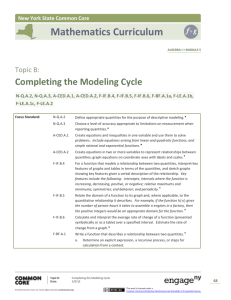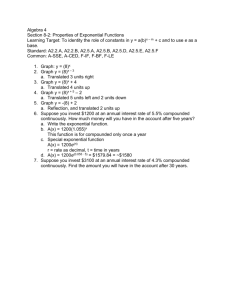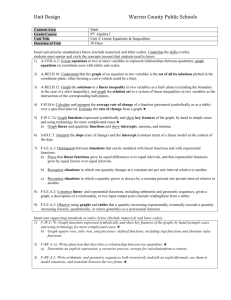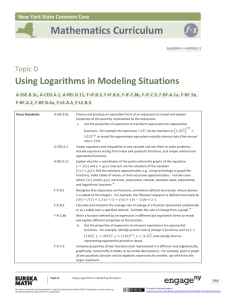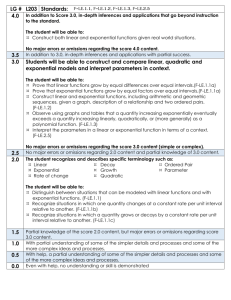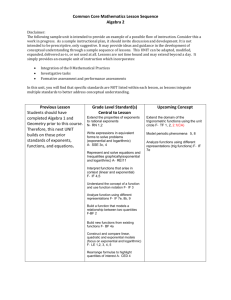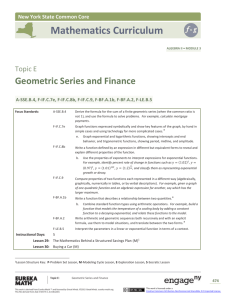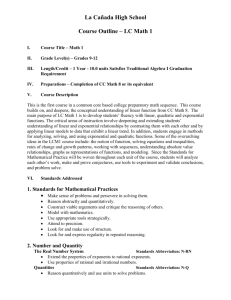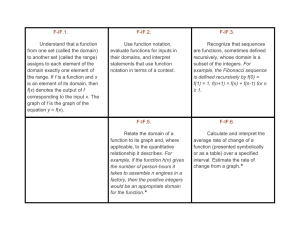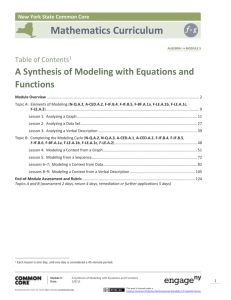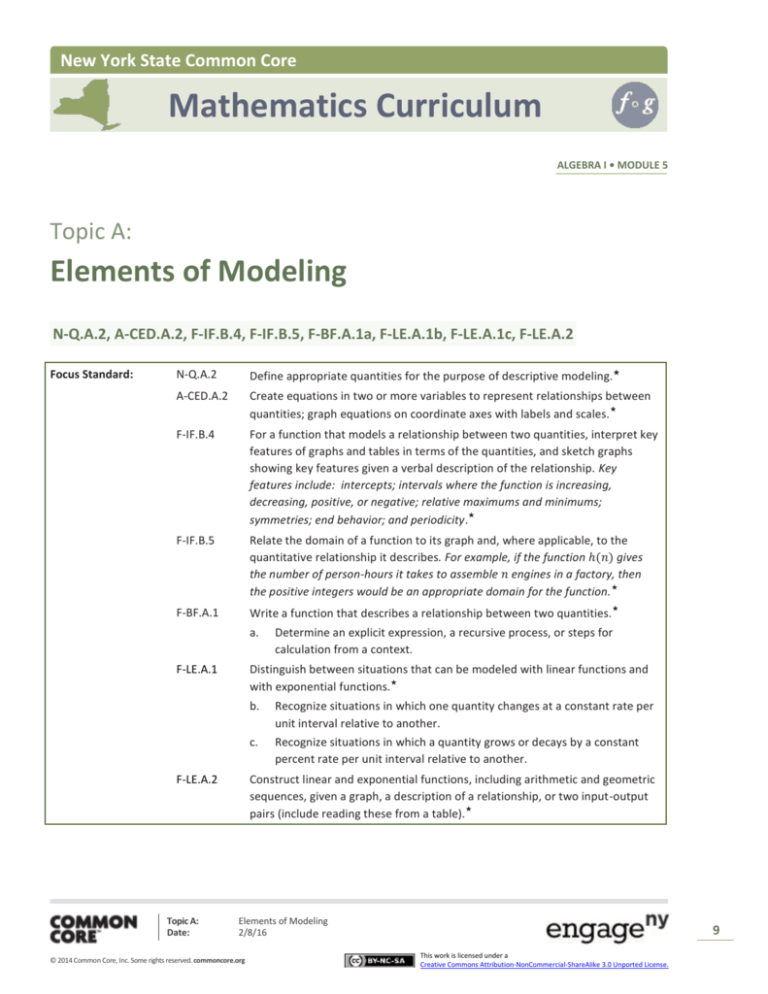
New York State Common Core
Mathematics Curriculum
ALGEBRA I • MODULE 5
Topic A:
Elements of Modeling
N-Q.A.2, A-CED.A.2, F-IF.B.4, F-IF.B.5, F-BF.A.1a, F-LE.A.1b, F-LE.A.1c, F-LE.A.2
Focus Standard:
N-Q.A.2
Define appropriate quantities for the purpose of descriptive modeling.★
A-CED.A.2
Create equations in two or more variables to represent relationships between
★
quantities; graph equations on coordinate axes with labels and scales.
F-IF.B.4
For a function that models a relationship between two quantities, interpret key
features of graphs and tables in terms of the quantities, and sketch graphs
showing key features given a verbal description of the relationship. Key
features include: intercepts; intervals where the function is increasing,
decreasing, positive, or negative; relative maximums and minimums;
★
symmetries; end behavior; and periodicity.
F-IF.B.5
Relate the domain of a function to its graph and, where applicable, to the
quantitative relationship it describes. For example, if the function ℎ(𝑛) gives
the number of person-hours it takes to assemble 𝑛 engines in a factory, then
★
the positive integers would be an appropriate domain for the function.
F-BF.A.1
Write a function that describes a relationship between two quantities.
a.
F-LE.A.1
Determine an explicit expression, a recursive process, or steps for
calculation from a context.
Distinguish between situations that can be modeled with linear functions and
★
with exponential functions.
F-LE.A.2
Topic A:
Date:
★
b.
Recognize situations in which one quantity changes at a constant rate per
unit interval relative to another.
c.
Recognize situations in which a quantity grows or decays by a constant
percent rate per unit interval relative to another.
Construct linear and exponential functions, including arithmetic and geometric
sequences, given a graph, a description of a relationship, or two input-output
★
pairs (include reading these from a table).
Elements of Modeling
2/8/16
© 2014 Common Core, Inc. Some rights reserved. commoncore.org
9
This work is licensed under a
Creative Commons Attribution-NonCommercial-ShareAlike 3.0 Unported License.
NYS COMMON CORE MATHEMATICS CURRICULUM
Topic A
M5
ALGEBRA I
Instructional Days:
3
Lesson 1: Analyzing a Graph (P)1
Lesson 2: Analyzing a Data Set (P)
Lesson 3: Analyzing a Verbal Description (P)
Topic A deals with some foundational skills in the modeling process. With each lesson, students build a
“toolkit” for modeling. They develop fluency in analyzing graphs, data sets, and verbal descriptions of
situations for the purpose of modeling, recognizing different function types (e.g., linear, quadratic,
exponential, square root, cube root, and absolute value), and identifying the limitations of the model. From
each graph, data set, or verbal description, students recognize the function type and formulate a model but
stop short of solving problems, making predictions, or interpreting key features of functions or solutions. This
topic focuses on the skill building required for the lessons in Topic B, where students will take a problem
through the complete modeling cycle. This module will deal with both “descriptive models” (such as graphs)
and “analytic models” (such as algebraic equations).
In Lesson 1, students recognize the function type represented by a graph. They recognize the key features of
linear, quadratic, exponential, cubic, absolute value, piecewise, square root, and cube root functions. These
key features include, but are not limited to, the 𝑥- and 𝑦-intercepts, vertex, axis of symmetry, and domain
and range, as well as domain restrictions dependent on context. They then use the key features and/or data
pairs from the graph to create or match to an equation that can be used as another representation of the
function; some examples use real-world contexts.
Lesson 2 follows the same blueprint. Instead of a graph, students are given a data set presented as a table
and asked to identify the function type based on their analysis of the given data. In particular, students look
for patterns in the data set at fixed intervals to help them determine the function type, e.g., while linear
functions have constant first differences (rate of change), quadratic functions have constant second
differences (rate of the rate of change), and exponential functions have a common ratio (constant percent
change).
Lesson 3 asks students to make sense of a contextual situation presented as a word problem or as a situation
described verbally. They start by making sense of the problem by looking for entry points, analyzing the
givens and constraints, and defining the quantities and the relationships described in the context. They
recognize specific situations where linear, quadratic, or exponential models are typically used.
1
Lesson Structure Key: P-Problem Set Lesson, M-Modeling Cycle Lesson, E-Exploration Lesson, S-Socratic Lesson
Topic A:
Date:
Elements of Modeling
2/8/16
© 2014 Common Core, Inc. Some rights reserved. commoncore.org
10
This work is licensed under a
Creative Commons Attribution-NonCommercial-ShareAlike 3.0 Unported License.

